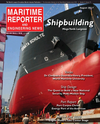
Page 72: of Maritime Reporter Magazine (August 2017)
The Shipyard Edition
Read this page in Pdf, Flash or Html5 edition of August 2017 Maritime Reporter Magazine
TRAINING & EDUCATION
Step #3:
Using Real Time Data Using Real Time Data
Photo: © Photocreo Bednarek / Adobe Stock to Improve Trainingto Improve Training veryone responsible for safety training and compliance challenges with improvement. Let’s get started. Starting the Ball Rolling or training in their organiza- the new and highly effective practice of Remember that the best structure for tion is very aware that every- blended learning. The ? rst article, which De? ning Success rolling out blended learning is an incre-
Ething is changing in the mari- appeared in the June edition of Mari- The overall outcomes we are looking mental approach – starting with a pilot, time world. The worker demographic time Reporter, focused on the creation to achieve are improved training results, and then continually adding more learn- has shifted. Regulatory demand is rising of a minimum viable plan (MVP) for the improved compliance tracking, and the ing materials covering a broader range and compliance is more complex. Fortu- pilot. This is a two or three page living ability to continuously measure the suc- of knowledge and competencies. Each nately, it is also the case that maritime document which acts as a roadmap for cess of our training to inform a process time we expand in this manner, this is an safety and training has entered a renais- the management of blended learning. of continuous improvement. This latter opportunity to take a retrospective look sance period. New tools are available The second article, in the July issue, dis- goal, continuous measurement and im- at how things have turned out up to this that improve training outcomes and al- cussed giving life to the plan by imple- provement, is the one that ensures that point. Was it a success overall? What low organizations to assess their state menting and running a blended learning we not only learn from mistakes, but that parts can be improved? What should of training and compliance with a level pilot. we are always improving and ? ne tuning we do differently next time? So here we of insight not previously possible. At There, aspects such as engagement, our processes to achieve the best pos- analyze (measure how well things are the heart of these tools is the practice of the choice of training materials and the sible outcomes. going) and adapt (brainstorm and imple- blended learning supported by a Learn- use of a learning management system It is often said that if we do not take ment ideas that we believe will improve ing Management System (LMS) - soft- (LMS) were covered. This third article this step to monitor and improve train- the outcomes next time we measure).
ware to deliver training, assessments, completes the series by presenting what ing outcomes, we can be con? dent that At this point in our process, we have tracking and insights. is arguably the most important aspect of those outcomes are continually worsen- created a simple plan, and we have de-
This is the third and ? nal in a series of any critical operational activity – mea- ing. So success here is de? ned as having signed and run a pilot implementation. short articles that provides step-by-step suring our success and using those result a simple and ef? cient process to achieve Now our ? rst opportunity to analyze and instructions to address modern safety, to begin the ongoing cycle of continuous continuous improvement. adapt has arrived.
72 Maritime Reporter & Engineering News • AUGUST 2017
MR #8 (66-73).indd 72 MR #8 (66-73).indd 72 8/7/2017 2:55:12 PM8/7/2017 2:55:12 PM

 71
71

 73
73
